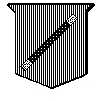Baton sinister

Baton sinister is a charge used in heraldry.
Heraldic charge
It is a diminutive of the bend sinister and constitutes a narrow strip that runs from the upper right to the lower left of a coat of arms. Sinister (meaning left in Latin) is merely a directional indicator, and does not carry the negative connotations of the word in modern English.
It is commonly believed to be an indicator of an illegitimate birth in the family line, and is used in this way in literary contexts. For example, the hero of John Buchan’s historical novel, John Burnet of Barns, set in the sixteenth century, on being told that he is the son of Lady Eleanor Percy, was reassured that ‘there is no bar sinister on your shield. You were born in lawful wedlock, a second son.’
However, in medieval England, there was no single mark of difference for bastardy. Until the late fourteenth century, the same marks of cadency were used for both illegitimate and legitimate children, but thereafter the arms of some bastards took the form of a plain or party field with their fathers’ arms on a figure such as a bend, fess, chief, chevron or quarter.[1]
The baton sinister can be seen in the arms of the Duke of Grafton, descended from an illegitimate son of King Charles II of England. Today, the College of Arms in England uses a bordure wavy to mark an armiger as illegitimate. The Court of the Lord Lyon in Scotland uses a bordure gobony to denote the same.
Bar sinister
In French blazon a bend sinister is called a barre. Sir Walter Scott is credited with giving literature the macaronic phrase bar sinister, which has become a metonymic term for bastardy. In English blazon a bar is a horizontal stripe, symmetric with respect to sinister and dexter. (Bar and barre are pronounced alike.)
See also
External links
- Baton sinister in the arms of the Duke of Grafton
- Society for Creative Anachronism
- Pembley's Dictionary of Heraldry
References
- ↑ A Wagner, ‘Medieval Heraldry’ in A L Poole ed. Medieval England vol 1 (Oxford 1958) pp. 363-8
- This article incorporates text from a publication now in the public domain: Wood, James, ed. (1907). "article name needed". The Nuttall Encyclopædia. London and New York: Frederick Warne.
- Stephen Friar, Ed. A Dictionary of Heraldry. (Harmony Books, New York: 1987).